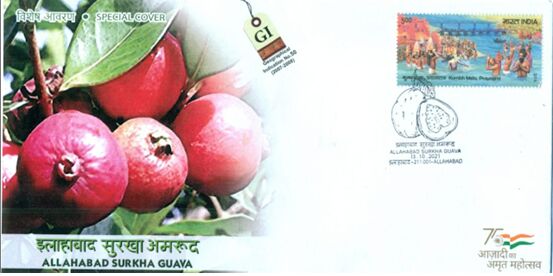Uniquely tinctured guavas
Found in limited supply and strictly seasonal, Allahabad’s Surkha Amrood — distinguished from other varieties by its apple-red exterior and deep pink interior — entails the ‘legend, mystique and charm of Sangam’

If Darjeeling is famous for its tea, Dehradun for its basmati, Nagpur for its santras (oranges) and Andhra for its Banganapalle mangoes, Allahabad is famous for its rich and lush variety
of 'amroods' or guavas. Owing to this phenomenon, Allahabad is often referred to as 'The City of Green Gold' and, as the most prominent 19th century muse from the city put it:
Kuch Allahabad mein samaan nahin behbood ke
Yaha dhara kya hai, bazooz akbar aur amrood ke
(In the city of Allahabad, not much is of worth!
Except the poet Akbar, and the divine fruit, amrood)
These beautiful lines of Akbar Allahabadi perhaps explain why the heady scented flavoured guava from Allahabad has not only received the GI tag, but is also part of the legend, mystique and charm of the geographically distinct triangular region of Sangam at Prayagraj where Ganga and Jamuna connect with the mythical Saraswati. It is said that the closer the orchard is to the Sangam, the more vibrant is the hue of pink!
This is what makes Allahabad Sebiya or Allahabad Surkha unique and different from guavas grown elsewhere. It has an apple-red exterior and a succulent deep pink colour inside; hence, the name 'Surkha'. Its natural habitat is the 300 hectares land in Doab in Kaushambi district of the erstwhile undivided Allahabad. The two blocks where it is grown – Muratganj and Chail — have been declared 'fruit belt' by the state government. Both the Mission for the Integrated Development of Horticulture (MIDH) and its predecessor programme National Horticulture Mission (NHM) have extended support to better agronomic practices as well as micro-irrigation for this precious commodity. Interventions also include high-density plantations as urbanisation is cutting into the core area of Surkha production. Its time governments realised that while housing colonies can be built anywhere, the Surkha Amrood can be grown only in and around Sangam.
The amrood is special, not just for the residents, tourists and pilgrims, but also for passengers in transit who make a beeline for this remarkable fruit during the brief halt of the train at the Prayagraj junction. Allahabadis are known to send guavas as festive gifts to their acquaintances and relatives in winter (November-February); and it is more cherished than dry fruits or sweets because of its seasonality, limited availability and a very short shelf life. If you are not in Allahabad, and if you are not in the season of the fruit, no amount of money can get you to bite your teeth into the fruit which became the inspiration for the poet!
To place the guava production in perspective, let us understand that compared to the production of three lakh thousand MT of bananas, and two lakh thousand MT of mangoes, the third, fourth and fifth highest fruit crops in India, viz papaya, mandarin oranges and guava are way behind at six thousand, five thousand and four thousand MT respectively. The production of guava is concentrated in the states of Maharashtra, Bihar, UP and West Bengal – but nowhere does the fruit have 'surkha colour and flavour'.
The craze for Allahabad guava remains unaltered over the years even with the recent name change to Prayagraj. In addition to the surkha, Allahabad guava also has its own identity in the other varieties of safeda, narma and patta. Of these, safeda has the maximum production. It is yellowish white, round, soft-skinned, pleasantly flavoured, with white firm flesh, and is grown across the subcontinent. This is also the preferred variety for processing and confectionary (jellies, jams and juices).
However, it is only the Surkha Guava that applied for, and received the GI tag way back in 2008. The GI is held by the producers themselves under the banner of the Allahabad Surkha Amrood Utpadak Welfare Association. The application made to the GI registry stated: "the famous apple-coloured guava variety, Allahabad Surkha, though not a native race of India, originated as a chance seedling in the village Abbubakarpur in the Allahabad district".
To celebrate the Surkha, and make it popular across the globe, the postal department acknowledged the salience of Allahabad Surkha and brought out a Special cover on the fruit! This special cover can be purchased, irrespective of the season! However, to bite into this fruit it is best to plan a visit to city from November to February, take a dip in the Sangam, and buy a crate of it for distributing it to friends and family.
Views expressed are personal



